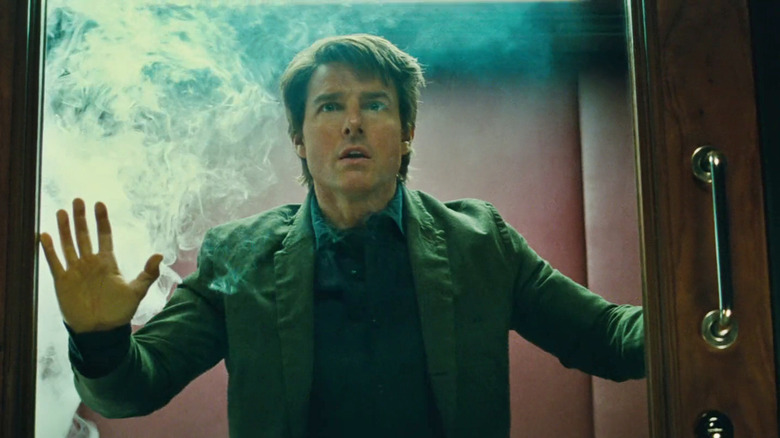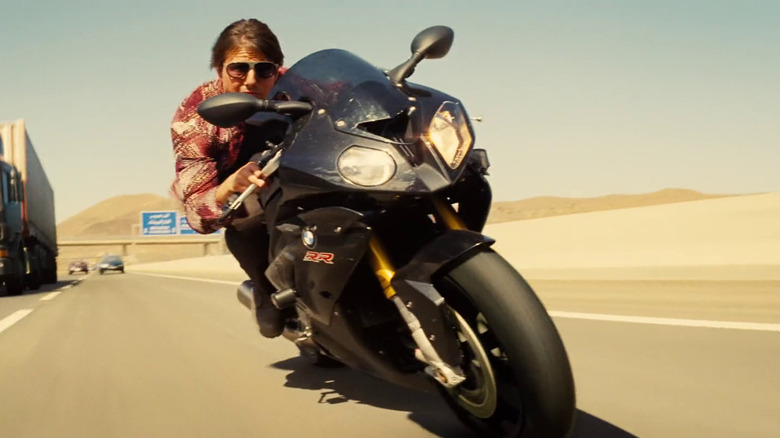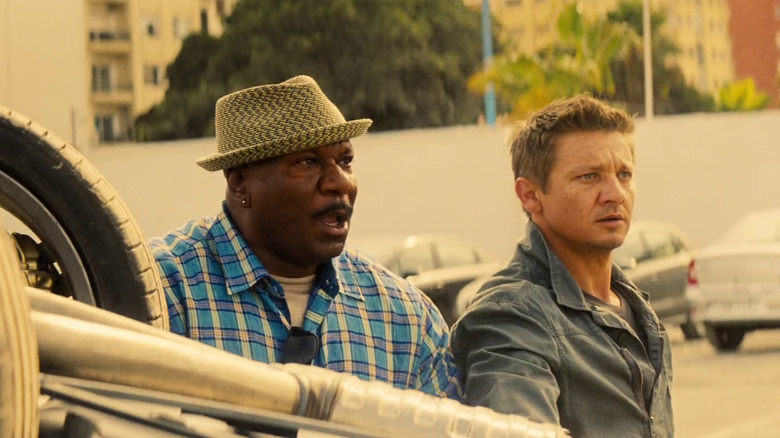One Mission: Impossible Movie Reinvented The Franchise As We Know It
God bless Brad Bird. He was the director tasked with the revival of the "Mission: Impossible" franchise in 2011, after J.J. Abrams concluded the initial three films in the series with "Mission: Impossible III," and he laid down the groundwork for future installments, aiming to be bigger, better, and more blistering than ever before. Bird's "Mission: Impossible — Ghost Protocol" was a blast. It opened the floodgates for a goofier yet also more intense, and even more action-oriented line of movies that set out to be hyper-exhilarating and adrenaline-fueled spectacles.
But it wasn't until Christopher McQuarrie's first entry in the franchise, "Mission: Impossible — Rogue Nation," that the Tom Cruise-powered features reached their full potential. The fifth installment was absolute peak, leaning heavily into the breathtaking stunts and elaborate set pieces that propelled the franchise into new, formerly unseen heights. Yet "Rogue Nation" also managed to strike a balance by offering the best of two worlds: Keeping (and upping) the fundamentals of the spy formula while focusing on the increasingly bolder and monumental action sequences that dared to defy the limitations of what a blockbuster like this can do.
Sure, perhaps that could be said about the sequels, too — the spectacular "Mission: Impossible — Fallout" and "Dead Reckoning" — but "Rogue Nation" was the first, fully-fledged specimen that set the pattern and perfect blueprint for the successors to follow.
The beautiful harmony of thrilling, high-octane chaos
It's easy to forget what these movies are about when you're pulled from one rapid chase scene to another, tossed into an underground water tank, or forced to jump on an airplane that's taking off, but "Rogue Nation" stands out in that aspect, too. Narratively, it's the first time in "M:I" history when the IMF (Impossible Missions Force) is getting (temporarily) shut down, essentially turning Ethan Hunt (Tom Cruise) into a fugitive. He has to go on the run from the very agency that employs him while trying to stop the latest terrorist organization called The Syndicate, which is led by Solomon Lane (Sean Harris) and assembled from various field operatives belonging to separate intelligence agencies that have gone rogue. McQuarrie, who wrote the story with Drew Pearce, smartly builds the stakes and unleashes numerous threats on Hunt that pay off handsomely in terms of mounting suspense that drives the movie from the first second to the last. It's a slight narrative shift from what we've seen before, yet one that aptly aligns with the tone of the director's storytelling style.
Make no mistake, though, the selling point of "Rogue Nation" — and really, every "Mission: Impossible" movie starting with the fourth movie — is the wilder-than-ever action set pieces. While "Ghost Protocol" truly had one unbelievably nail-biting and magnificent stunt (Ethan Hunt climbing the Burj Khalifa skyscraper in Dubai), "Rogue Nation" is practically filled with them, starting with the very first scene where Hunt jumps on an airplane and mounts its side while it takes off to the insanely claustrophobic and uncomfortable underwater sequence in a vault where he needs to hold his breath for almost six minutes. Then there's the fiasco at Vienna State Opera, the car chase on the streets of Casablanca, and so on. The great thing, of course, is that Cruise did most of those stunts on his own, trying to save the big-budget movie as we know it.
McQuarrie masterfully blends all this together and produces a breakneck, rousing combo of high-end cinema that truly feels like a reinvention.
Rogue Nation provided an exquisite, revitalized, and extended ensemble cast
Beyond all the technical achievements and wondrous stunts, however, "Rogue Nation" also found the best possible cocktail of an ensemble cast as far as the "Mission: Impossible" films go. In addition to the regulars in "Ghost Protocol" (Cruise, Simon Pegg, and Jeremy Renner), McQuarrie introduced Rebecca Ferguson's dangerously sexy femme fatale Ilsa Faust, who, since this movie, became a beloved fan favorite. No wonder why: If you ask me, the actress ran circles around most Bond girls with a performance brimming with vivaciousness, defiance, and an aura the franchise never had to this extent. Unsurprisingly, her unexpected exit in "Dead Reckoning" left fans fuming and disappointed. Besides her, casting Alec Baldwin as the determined and fierce CIA director Alan Hunley was also a smart move alongside Sean Harris's restrained yet threatening villain. And for good measure, the return of Ving Rhames as Luther (not only for a cameo this time) was the kind of nostalgic touch that generally makes long-time movie lovers happy.
This terrifically talented cast didn't just simply work, but set the perfect example for a fiery yet harmonious and amusing dynamic between a group of actors who can elevate the vibe and calibre of a movie together to another level. That's not to say the sequels failed on this front, but in "Rogue Nation," everything came together in the best way possible.
In essence, McQuarrie amplified every feature and defining quality that made the franchise what it is today by showing us how effective they can be when hitting that imaginary top-tier ceiling. Naturally, opinions will always differ regarding what's the ultimate best in the "Mission: Impossible" canon, but it's hard to argue against "Rogue Nation" as one of the strongest — if not the strongest — contenders.


